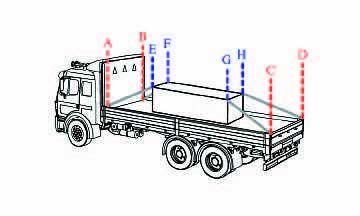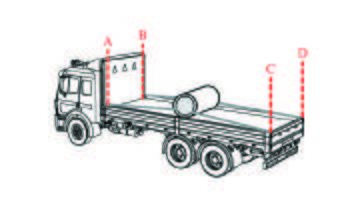Review Questions - Click On The Picture To Begin...

As part of their pre-trip cargo securement inspection, drivers should:
- Inform carrier of any inadequate packaging.
- All of these apply.
- Make sure cargo is properly secured.
- Check for anything that will obscure their vision.
Quote From The CDL Manual:
Driver inspection checklist:
Pre-Trip
- Make sure that cargo is properly distributed and adequately secured (in other words, according to the Standard).
- Make sure that all securement equipment and vehicle structures are in good working order and used consistent with their capability.
- Stow vehicle equipment.
- Make sure that nothing obscures front and side views or interferes with the ability to drive the vehicle or respond in an emergency.
-
Inform carrier if packaging is not adequate. For example:
- Banding is loose or not symmetrical on package.
- Banding attachment device(s) are inefficient.
- Wrapping is broken or ineffective.
- Pallets are broken.
Next
A container chassis vehicle is defined as:
- A specialized container, primarily used to contain and transport materials in the waste, recycling, construction/demolition, and scrap industries, which are used in conjunction with specialized vehicles, in which the container isloaded and unloaded onto a tilt frame body by an articulating hook-arm.
- A structure, device, or another substantial article placed against an article to prevent it from tipping that may also prevent it from shifting.
- A reusable, transportable enclosure that is especially designed with integral locking devices that secure it to a container chassis trailer to facilitate the efficient and bulk shipping and transfer of goods by, or between various modes of transport, such as highway, rail, sea, and air.
- A vehicle especially built and fitted with locking devices for the transport of intermodal containers.
Quote From The CDL Manual:
Container Chassis Vehicle:
A vehicle especially built and fitted with locking devices for the transport of intermodal containers.
Prev
Next
A dunnage bag is:
- A structure, device, or another substantial article placed against or around an article to prevent horizontal movement of the article.
- A waterproof sheet used to cover cargo.
- A transverse load bearing structural component, particularly a part of a log bunk.
- An inflatable bag intended to fill otherwise empty space between articles of cargo, or between articles of cargo and the wall of the vehicle.
Quote From The CDL Manual:
Dunnage bag:
An inflatable bag intended to fill otherwise empty space between articles of cargo, or between articles of cargo and the wall of the vehicle.
Prev
Next
What is a cab shield?
- A vertical barrier placed directly behind the cab of a tractor to protect the cab in the event cargo should shift forward.
- A structure, device, or another substantial article placed against or around an article to prevent horizontal movement of the article.
- The depression formed between two cylindrical articles when they are laid with their eyes horizontal and parallel against each other.
- A vertical barrier across the front of the deck of a vehicle to prevent forward movement of cargo.
Quote From The CDL Manual:
The load carrying area of a truck, trailer, or intermodal container.
Prev
Next
The Aggregate Working Load Limit should, at minimum, be:
- Determined by the shipper.
- 80% of the weight of the cargo.
- 100% of the weight of the cargo.
- 50% of the weight of the cargo.
Quote From The CDL Manual:
How much should the Aggregate Working Load Limit be?
The aggregate working load limit of any securement system must be at least 50% of the weight of the cargo being secured.
Prev
Next
Who is responsible for inspecting securing devices and cargo within the first 50 miles?
- The D.O.T.
- Your Moms.
- The driver.
- The shipper.
Quote From The CDL Manual:
Inspect Cargo and Securing devices:
- Pre-Trip: Yes
- Within first 50 mi: Yes
- When duty status of driver changes: Yes
- At 3 hour intervals or every 150 mi, whichever is first: Yes
Prev
Next
What is the Aggregate WLL of the securement system for a load secured with 7 tiedowns: 3 rated at WLL of 4,000 lbs, 2 at 6,500, and 1 at 8,000?
- 10,000 lbs
- 33,000 lbs
- 16,500 lbs
- 8,250 lbs
Quote From The CDL Manual:
How do you calculate Aggregate Working Load Limit for tiedowns?
To calculate Aggregate Working Load limit, add together:
- 50% of the WLL of each end section of a tiedown that is attached to an anchor point.
- 50% of the WLL of each end section that is attached to the cargo
Prev
Finish
Please select an option





 Related Cargo Securement Terms That Every Driver Should Know:
Related Cargo Securement Terms That Every Driver Should Know: 



 TT On Facebook
TT On Facebook